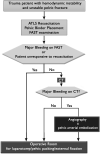Management of Pelvic Ring Injury Patients With Hemodynamic Instability
- PMID: 33282907
- PMCID: PMC7688898
- DOI: 10.3389/fsurg.2020.588845
Management of Pelvic Ring Injury Patients With Hemodynamic Instability
Abstract
Pelvic ring injuries (PRI) are among the most difficult injuries to deal with in orthopedic trauma. When these injuries are accompanied by hemodynamic instability their management becomes significantly more complex. A methodical assessment and expeditious triage are required for these patients followed by adequate resuscitation. A major triage decision is whether these patients should undergo arterial embolization in the angiography suit or prompt packing and pelvic stabilization in the operating room. Patient characteristics, fracture type and injury characteristics are taken into consideration in the decision-making process. In this review we discuss the acute evaluation, triage and management of PRIs associated with hemodynamic instability. An evidence based and protocol driven approach is necessary in order to achieve optimal outcomes in these patients.
Keywords: angioembolization; bleeding; hemodynamic instability; pelvic fracture; pre-peritoneal pelvic packing; resuscitation; shock; triage.
Copyright © 2020 Marmor, El Naga, Barker, Matz, Stergiadou and Miclau.
Figures
Similar articles
-
Secondary Angio-Embolization After Emergent Pelvic Stabilization and Pelvic Packing Is a Safe Option for Patients With Persistent Hemorrhage From Unstable Pelvic Ring Injuries.Front Surg. 2020 Dec 17;7:601140. doi: 10.3389/fsurg.2020.601140. eCollection 2020. Front Surg. 2020. PMID: 33392246 Free PMC article.
-
Unstable pelvic ring injury with hemodynamic instability: what seems the best procedure choice and sequence in the initial management?Orthop Traumatol Surg Res. 2013 Apr;99(2):175-82. doi: 10.1016/j.otsr.2012.12.014. Epub 2013 Feb 23. Orthop Traumatol Surg Res. 2013. PMID: 23462306
-
The role of angio-embolization in the acute treatment concept of severe pelvic ring injuries.Injury. 2015 Oct;46 Suppl 4:S33-8. doi: 10.1016/S0020-1383(15)30016-4. Injury. 2015. PMID: 26542864
-
Preperitoneal pelvic packing: Technique and outcomes.Int J Surg. 2016 Sep;33(Pt B):222-224. doi: 10.1016/j.ijsu.2016.05.072. Epub 2016 Jul 1. Int J Surg. 2016. PMID: 27373522 Review.
-
Management of Bleeding Pelvic Fractures.Scand J Surg. 2014 Jun;103(2):104-111. doi: 10.1177/1457496914525604. Epub 2014 Apr 15. Scand J Surg. 2014. PMID: 24737854 Review.
Cited by
-
Effect of C-Clamp Application on Hemodynamic Instability in Polytrauma Victims with Pelvic Fracture.Medicina (Kaunas). 2022 Sep 16;58(9):1291. doi: 10.3390/medicina58091291. Medicina (Kaunas). 2022. PMID: 36143972 Free PMC article.
-
Case-Based Virtual Reality Simulation for Severe Pelvic Trauma Clinical Skill Training in Medical Students: Design and Pilot Study.JMIR Med Educ. 2025 Jan 17;11:e59850. doi: 10.2196/59850. JMIR Med Educ. 2025. PMID: 39823600 Free PMC article.
-
The pathophysiology of pelvic ring injuries: a review.Patient Saf Surg. 2024 May 13;18(1):16. doi: 10.1186/s13037-024-00396-x. Patient Saf Surg. 2024. PMID: 38741186 Free PMC article. Review.
-
Advances in Managing Pelvic Fractures in Polytrauma: A Comprehensive Review.J Clin Med. 2025 Feb 23;14(5):1492. doi: 10.3390/jcm14051492. J Clin Med. 2025. PMID: 40094956 Free PMC article. Review.
-
Hemorrhage control in pelvic ring injuries: the role of PCCDs and other acute measures in Germany.Eur J Trauma Emerg Surg. 2025 Apr 3;51(1):159. doi: 10.1007/s00068-025-02836-4. Eur J Trauma Emerg Surg. 2025. PMID: 40178683
References
-
- American College of Surgeons Advanced Trauma Life Support. 10th ed Chicago, IL: American College of Surgeons; (2018).
-
- Mutschler M, Nienaber U, Brockamp T, Wafaisade A, Fabian T, Paffrath T, et al. . Renaissance of base deficit for the initial assessment of trauma patients: a base deficit-based classification for hypovolemic shock developed on data from 16,305 patients derived from the TraumaRegister DGU®. Crit Care. (2013) 17:R42. 10.1186/cc12555 - DOI - PMC - PubMed


